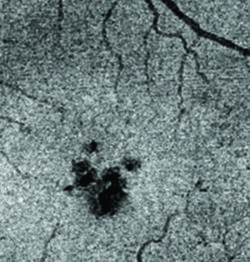
This en face OCT image of a MacTel eye shows a disruption in photoreceptors (dark patch) in the foveal region of the retina.
Advanced imaging technologies have changed our understanding of disease progression in macular telangiectasia type 2. Clinicians affiliated with the Lowy Medical Research Institute are using new imaging modalities to diagnose and follow changes in the MacTel eye. Some of these imaging modalities were developed for research purposes, or are in early stages of development with manufacturers. Many such specialized devices are not yet widely available across all LMRI-affiliated clinical sites.
Some of these technologies capture very high-resolution pictures of the retina, in some cases down to the cellular level. For example, scientists can see individual photoreceptors by adaptive optics imaging. Some clinicians who participate in the MacTel Project have specialized OCT devices that allow them to see blood vessels in the eye, with optical coherence tomography-angiography (OCT-A) machines. Recent research indicates that the MacTel retina has a signature pattern observed by fluorescence lifetime imaging ophthalmoscopy (FLIO), which may allow for earlier diagnosis in the future, or diagnosis among family members. While not widespread, such specialized imaging devices are very important to MacTel research.
Other imaging technologies, including optical coherence tomography (OCT) and microperimetry, are in use by members of the MacTel clinical community around the world.




